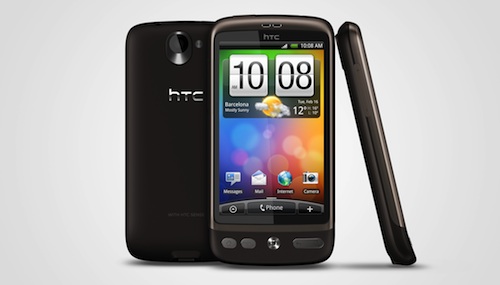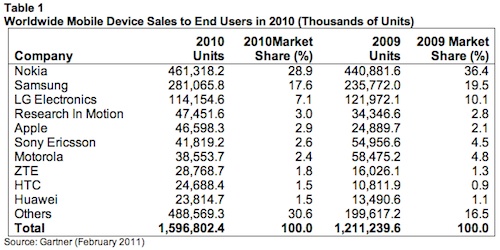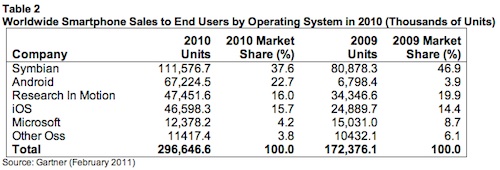
Smartphone sales soared 72,1% from 2009 to 2010 and accounted for 19% of total mobile communications device sales, new research from Gartner shows. That means nearly one in five phones now sold is a smartphone.
Worldwide mobile device sales — those that were bought by end users — rose 31,8% in 2010.
“Strong smartphone sales in the fourth quarter of 2010 pushed Apple and Research In Motion (RIM) up in our 2010 worldwide ranking of mobile device manufacturers to the number five and four positions respectively, displacing Sony Ericsson and Motorola,” says Carolina Milanesi, research vice president at Gartner.

“Nokia and LG saw their market share erode in 2010 as they came under increasing pressure to refine their smartphone strategies.”
In 2010, Nokia’s annual phone sales to end users reached 461,3m units, a 7,5% drop in market share from 2009. The year-on-year decline is not solely attributable to Nokia’s continuing deficiency in high-end devices but is, in part, the result of the growth of legitimate white-box sales.
Nokia’s share of the smartphone market dropped 6,7% percentage points from 2009 and the company’s future rests on the announcements it will make on 11 February and how well the company can execute on those plans in the limited time available, Gartner says.
RIM’s sales in 2010 reached 47,5m, an increase of 38,2%. The strong performance rested on aggressively priced prepaid offerings, as well as a steady uptake of the BlackBerry Messenger service.
Despite growing volume sales, RIM was unable to keep up with market growth and its market share declined from 19,5% in the fourth quarter of 2009 to 13,7% in the fourth quarter of 2010.

Apple sold 46,6m units in 2010, representing an 87,2% improvement on 2009. The growth is largely due to expansion into new countries and the ending of exclusivity deals, which has made the iPhone available through 185 operators around the world. The end of exclusivity deals also encouraged competition on voice tariffs and data plans, making the total cost of iPhone ownership more in line with other high-end smartphones.
The smartphone market remains concentrated in advanced markets, where buyers have more disposable income and where networks are fast enough to support smartphones’ full feature sets, according to Gartner.
“Western Europe and North America accounted for 52,3% of global smartphone sales in the fourth quarter of 2010,” says Gartner principal research analyst Roberta Cozza.
In the smartphone operating system market, Android grew 888,8% in 2010 and moved to the number two position. Android sales in the fourth quarter of 2010 continued to be driven by broad availability of many high-end products from HTC (Desire range, Incredible and Evo), Samsung (Galaxy S) and Motorola (Droid X, Droid 2).
Symbian’s market share dropped further in the fourth quarter of 2010 to 32.6%, or 32,6m units. This allowed Android to overtake Nokia’s Symbian unit sales during the fourth quarter of 2010. However, the Symbian OS is also used by Fujitsu and Sharp as well as in legacy products from Sony Ericsson and Samsung. “This aggregated volume kept Symbian slightly ahead of Android,” says Cozza.
The wider availability of the iPhone 4 helped Apple to maintain its share of the smartphone market at 16% in the fourth quarter 2010 and resulted in the iPhone’s iOS platform reaching the number four position in 2010.
Shortages continued to affect popular components, such as camera modules, touch-screen controllers, and active-matrix organic light-emitting diode (Amoled) screens, in the fourth quarter of 2010. Gartner says this situation will not ease until at least the second half of 2011. — Staff reporter, TechCentral
- Subscribe to our free daily newsletter
- Follow us on Twitter or on Facebook




